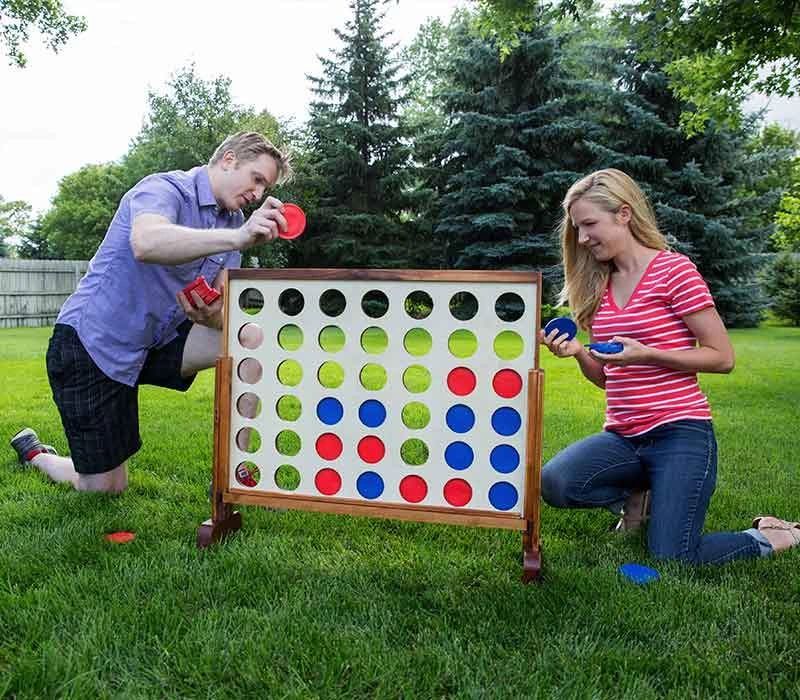Post by Steve King (Admin) on Jun 8, 2006 11:05:52 GMT -6



ring toss game
Material List
Item Qty. Description
#1 - Hardwood or plywood for the base. You can make the ring toss game in a variety of sizes; we used two pieces of 3/4" x 1.5" x 16" (20 x 40 x 400mm) and two pieces of 3/4" x 1.5" x 7.25" (20 x 40 x 180mm) plywood
#2 10 Wood screws or drywall screws. The length of the screws should be about 1.5 times the thickness of the wood you are using - we used 1.25" (30mm) long screws.
#3 - Woodworking glue
#4 5 Wood dowel. We used a 3/4" (20mm) diameter hardwood dowel. You will need five pieces about 5" (125mm) long.
#5 - Paint. We used three different colors of standard craft paint.
#6 3 Rope, nylon preferred, but other types will suffice. We used three 16" (400mm) long ropes that were 1/2" (13mm) in diameter.
#7 3 Copper couplings and construction adhesive to fuse the ends of the ropes into rings; alternatively tape can be used.
#8 - Polyurethane coating (optional). After the paint dries, you can follow with a coat of clear polyurethane for increased durability.
Tool List
Tool
Drill press with forstner bit to match diameter of dowel
Hand drill with countersinking bit
Disk sander
Clamps
Square
Table saw
Router with rounding over bit
Paintbrush
Candle and matches (to fuse end of nylon rope as a means of minimizing fraying)
The procedure to make the ring toss game is very straightforward. You can begin by working on the base. Start by cutting some plywood (hardwood can also be used) into equally wide strips. We used 3/4" (20mm) thick plywood and cut 1.5" (40mm) wide strips. You will need two long pieces and four shorter pieces as described in the material list.
the ring toss base is made from two long strips and four shorter strips of wood
Next we are ready to complete the assembly of the ring toss base. Clamp the pieces together on a flat surface to create a cross. The side facing up will become the underside of the base. All the pieces should fit squarely to each other - you can confirm the squareness with a square. Using a countersinking bit, drill holes into the wood, but do not penetrate through the other side (which will become of the top of the game). Drill at least two holes in the center section where the two long pieces overlap, but leave room in the very center for one of the wooden dowels.
begin by drilling a hole in the wall where you want to position the clock
Drive screws into the holes that you have just created. You can increase the holding power by using woodglue before assembling all of the pieces together. Screws would surely be enough, as would glue alone, but since this game is designed to endure years of rugged use, we relied on both. After assembly, you can round off the four ends by marking radii and then removing the material with a disk sander. Once you are satisfied with the ends you can knock off all of the edges using a router and a rounding over bit. The final step in the preparation of the ring toss base, is to drill five holes (blind, not through) as shown in the image on the right. The width of the holes, should match the diameter of the dowels that you are using, 3/4" (20mm) in our case.
assemble all the pieces of the ring toss game together
To complete the woodwork, cut five equal lengths of the hardwood dowel. 5" (125mm) long is a suitable dimension. Round off one end of each of the five dowels using a disk sander. Practice on a piece of scrap - after a few attempts, you can create beautiful rounded ends by rotating the dowel at various angles against the sanding surface. After a light sanding, paint all the pieces as desired. Painting the pieces now is much easier than after final assembly, unless you are painting everything the same color. After the paint has dried, glue the five dowels into place using wood glue.
cut an access hole with a utility knife and install the clock movement
The final step is to create the rope rings for the ring toss game. Cut three equal lengths of rope; subject both ends of each rope to a lighted candle to prevent fraying. To join the ends together to create a ring, you can use tape, but we opted for a more resilient solution. We used 1/2" (13mm) copper couplings available at plumbing stores. The 1/2" (13mm) dimension matches the diameter of the rope. After pushing one end of a rope halfway into the coupling, we applied some construction adhesive into the coupling and then firmly pressed in the other end of the rope thereby creating a ring. The result is a very strong and attractive rope ring.






